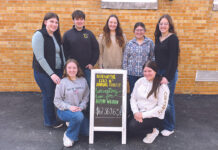
Like many of West Virginia’s agricultural sectors, the equine industry in West Virginia is small. West Virginia currently has about 5,300 horse farms and 24,000 horses. But it already draws economic activity through things like racing and trail riding, and nearly $6.5 million in annual equine sales.
And just like agriculture across West Virginia, it has room to grow.
That’s why the state’s department of agriculture, along with equestrians across the state, launched the West Virginia Horse Coalition Feb. 1 at Agriculture Day at the Legislature, in Charleston. The coalition is a public-private partnership that aims to promote and support the horse industry in West Virginia.
“We’re all part of the agricultural fabric of our state, so it’s important for everybody to be successful and productive,” said Jana Tetrault, an interim board member for the West Virginia Horse Coalition and executive director for the Mountaineer Park Horsemen’s Benevolent and Protective Association, in an interview with Farm and Dairy.
Industry
While the horse industry has its own unique challenges and goals, it also has a lot in common with other agricultural industries. For example, other livestock owners also need places to buy hay and grain for their livestock, and access to veterinarians.
In a Feb. 2 statement about the coalition, West Virginia’s agriculture commissioner, Kent Leonhardt, noted a successful equine industry would add more incentive for veterinarians to consider working in West Virginia.
“From hay and grain to tourism and connected business, expanding the equine industry will spur economic growth in our communities,” he wrote.
Coalition
Tetrault first discussed the coalition as an idea with Leonhardt in early 2021. She thought an industry group would be a good way to gather people from different equine disciplines across the state and work on improving the industry for all of them.
“[West Virginia’s horse industry is] very diverse, just like in most states,” Tetrault said. “I think it’s an underrepresented group in our state.”
There have been other attempts to form a similar group in West Virginia before, Tetrault said. But those groups had a difficult time moving forward. Leadership and support from Leonhardt made a big difference for the coalition.
“Just like expanding any agricultural industry in the state, as we foster growth, the impact of the horse industry will have down-stream effect on multiple sectors,” Leonhardt wrote. “We have a lot to gain by working together.”
With the department of agriculture’s backing, Tetrault and other interim board members started reaching out to people involved in the industry to invite them to a summit at the state fair in August. At the summit, they asked attendees to fill out a survey on the industry’s strengths and weaknesses.
More than 50 people attended. There were representatives from disciplines including quarter horses, racing, equine welfare, therapeutic riding, rodeo, saddlebred riding and more, as well as veterinarians and representatives from West Virginia University’s equine program. That meeting set the coalition, which has since added more than 40 people and 22 organizations, up to launch in February.
“People just came together, and we really had a good conversation on where we needed to go,” Tetrault said.
Goals
One of the next steps for the coalition is to get more information on the industry across the state. The coalition has chosen regional directors, who will work on driving membership, look at facilities and infrastructure for the industry in their region and conduct strength, weakness, opportunity and threat analyses in their regions.
“Right now, we have very little data on the horse industry except for what the [U.S. Department of Agriculture] provides in their annual surveys,” Leonhardt wrote. “Part of the problem is the industry is too small, so our federal partner doesn’t include more data on the industry in the U.S. Census of Agriculture. We cannot develop a path forward without first understanding the problems we have to tackle.”
Infrastructure is one current challenge for the industry, Tetrault said. Having better facilities for hosting shows and other events would help the state draw more people in for shows and as tourists.
The coalition also aims to serve as a central hub for information about West Virginia’s horse industry. That includes event listings, vet and farrier listings and information about things like trail systems and diseases that affect horses. They plan to develop educational programs on things like business in the horse industry and animal welfare, and also want to promote tourism connected with the industry.
The coalition is currently working on establishing itself as a nonprofit, and is planning to hold an official board election soon. The interim board members for now are Tetrault; Tim Ketterman, president of the West Virginia Quarterhorse Association; Maria Catigani, executive director for the Charles Town Horsemen’s Benevolent and Protective Association; and Greg Thomas, whose daughter shows saddlebred horses and who works in the state capitol.
“We just are really excited,” Tetrault said. “I think we can really showcase all the horse industry has to offer.”









